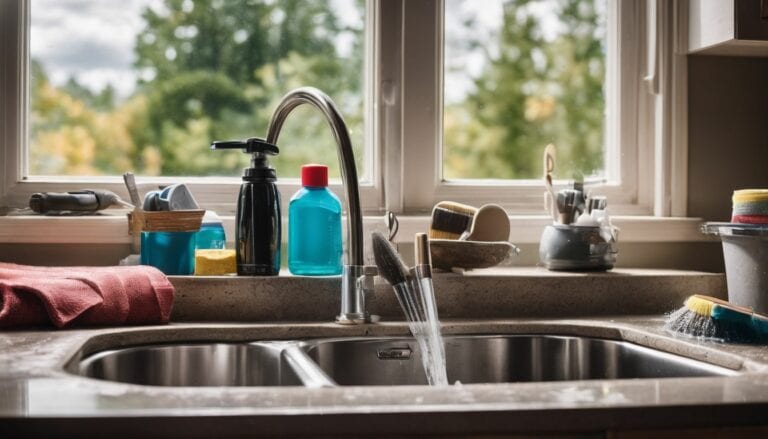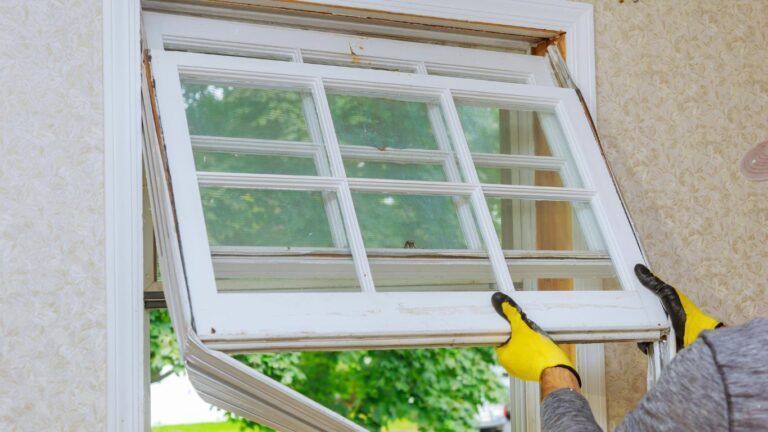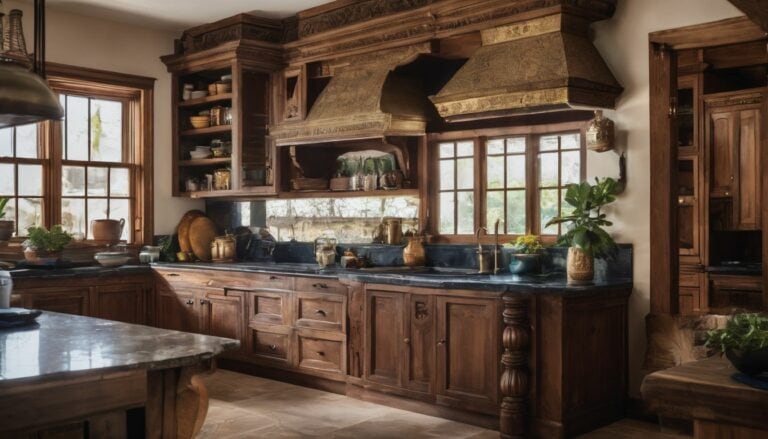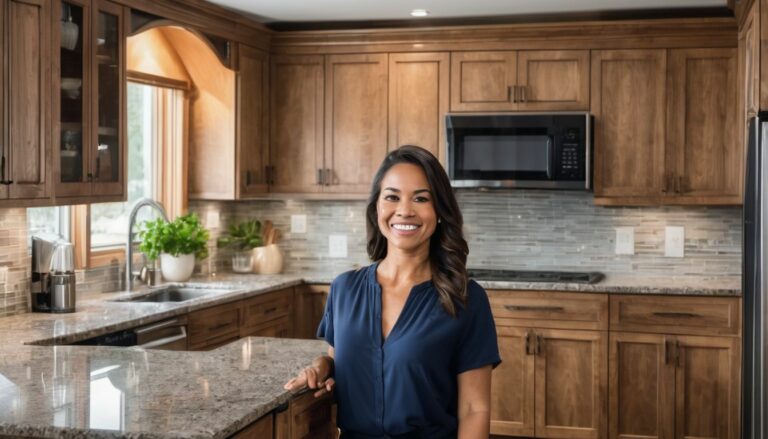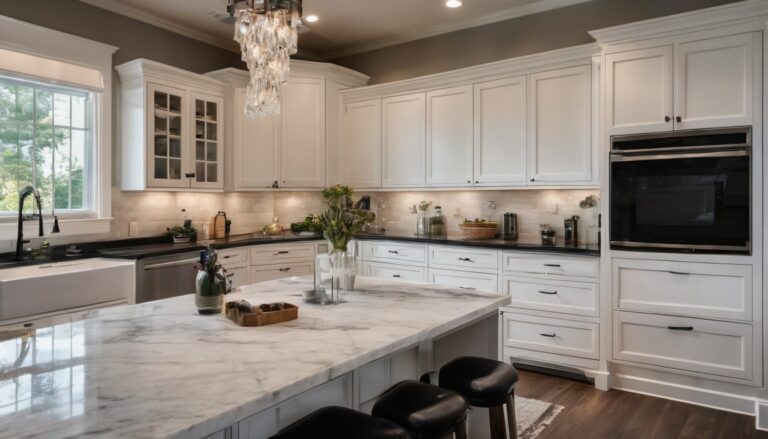Can Vinyl Kitchen Cabinets Be Painted? A Step-by-Step Guide
Imagine walking into your kitchen and being greeted by a fresh, vibrant space that feels brand new. It’s not a dream – with a little paint and creativity, you can transform your vinyl kitchen cabinets into stunning focal points. Painting vinyl cabinets is an excellent budget-friendly option for upgrading your kitchen without breaking the bank. But can you actually paint over vinyl wrap on kitchen cabinets?
Can Vinyl Kitchen Cabinets Be Painted?
The answer is yes! By following a few simple steps and considering some important factors, you can achieve beautiful results that will last for years to come. In this guide, we’ll explore the benefits of painting your vinyl kitchen cabinets, discuss the best techniques to use, and provide helpful tips along the way.
Cost of Painting Vinyl Kitchen Cabinets
If you’re looking to update your kitchen without breaking the bank, painting your vinyl cabinets can be a cost-effective solution. Vinyl cabinets are a popular choice for kitchens due to their durability and affordability, but they may not always match your desired aesthetic.
By painting them, you can transform the look of your cabinets and give your kitchen a fresh, new feel. However, before you embark on this project, it’s important to consider the cost involved in painting vinyl kitchen cabinets.
The cost of painting vinyl kitchen cabinets can vary depending on several factors, such as the size of the kitchen, the number of cabinets, the quality of materials used, and the region.
|
Factor |
Average Cost |
|---|---|
|
Cost per square foot |
$3 – $10 |
|
Cost per linear foot |
$30 – $70 |
|
Cost per cabinet door |
$25 – $150 |
|
Cost per drawer face |
$100 |
|
Average cost for a small kitchen |
$200 – $1,200 (DIY) / $1,000 – $3,500 (professional) |
|
Average cost for an average kitchen |
$2,000 – $6,500 (professional) |
|
Average cost for a large kitchen |
$3,000 – $10,000 (professional) |
The cost of painting vinyl kitchen cabinets typically includes the cost of materials, such as paint and primer, and labor costs, which can range from $25 to $75 per hour
The cost of materials and supplies typically required to paint kitchen cabinets, including masking tape and paper, surface repair and preparation material, primers, and cleanup supplies, can range from $400 to $1,000
It’s important to note that the cost of painting vinyl kitchen cabinets can vary significantly with site conditions and options, so it’s best to get an accurate estimate customized to the location, size, and options of your project
The cost of painting kitchen cabinets ranges from $200 to $1,200 (DIY) / $1,000 to $3,500 (professional).
Preparing Vinyl Covered Particleboard Cabinets
To achieve the best results when painting vinyl-covered particleboard cabinets, proper preparation is key. Here are some important steps to follow before you start painting:
Clean and Remove Dirt or Grease
Before you can paint your vinyl-covered particleboard cabinets, it’s crucial to clean them thoroughly. Use a mild detergent mixed with warm water to remove any dirt or grease that may have accumulated on the surfaces. Gently scrub the cabinets with a soft cloth or sponge, making sure to reach all the nooks and crannies.
Repair Damaged Areas
Inspect your vinyl-covered particleboard cabinets for any damaged areas such as chips, cracks, or peeling edges. If you come across any imperfections, it’s essential to repair them before applying paint. You can use wood filler or putty to fill in chips and cracks, ensuring a smooth surface for painting. Sand down any rough spots until they are even with the rest of the cabinet surface.
Ensure a Smooth Surface
For optimal paint adhesion, it’s important to create a smooth surface on your vinyl-covered particleboard cabinets. Start by lightly sanding the entire surface using fine-grit sandpaper. This will help remove any glossy finish and provide better adhesion for the paint. After sanding, wipe away any dust using a tack cloth so that it doesn’t interfere with the paint application.
Protect Non-Paintable Surfaces
While preparing your vinyl-covered particleboard cabinets for painting, it’s crucial to protect non-paintable surfaces such as hardware and laminate countertops. Use painter’s tape or masking tape to cover these areas and prevent accidental paint splatters or drips.
Apply Primer
To enhance adhesion and ensure an even finish, apply a primer specifically designed for laminate or vinyl surfaces. Using a brush or roller, apply thin coats of primer evenly over the cabinet doors and surfaces. Allow each coat to dry completely before applying the next one.
Choose the Right Paint
Using the right type of paint is essential. Opt for a high-quality, durable paint that is specifically formulated for use on kitchen cabinets. Look for paints that offer good adhesion and are resistant to heat, moisture, and stains.
Apply Paint in Thin Coats
To achieve a smooth and professional-looking finish, it’s best to apply paint in thin coats rather than thick layers. Using a brush or spray gun, apply the paint evenly over the cabinet surfaces. Allow each coat to dry completely before applying additional coats as needed.
By following these steps and taking the time to properly prepare your vinyl-covered particleboard cabinets, you can transform their appearance and give them a fresh new look. Remember to take your time and ensure each step is done thoroughly for the best results.
Painting Vinyl Wrap Kitchen Cabinets: Step-by-Step Guide
So, you’ve got vinyl wrap kitchen cabinets and you’re wondering if they can be painted. Well, the good news is that with the right techniques and materials, you can give your vinyl wrap cabinets a fresh new look. In this guide, we’ll walk you through the step-by-step process of painting your vinyl wrap kitchen cabinets.
Types of Paints Suitable for Painting Vinyl Wrap Kitchen Cabinets

It’s essential to choose the right type of paint that will adhere well to the surface and provide a durable finish. Here are some options to consider:
- Acrylic Paint: Acrylic paint is a popular choice for painting vinyl wrap kitchen cabinets due to its excellent adhesion properties and durability. It dries quickly and provides a smooth finish.
- Chalk Paint: Chalk paint is another suitable option for painting vinyl wrap cabinets. It offers good coverage and adheres well to various surfaces without requiring extensive prep work.
- Oil-Based Paint: Oil-based paint provides a hardwearing finish that can withstand everyday wear and tear in the kitchen. However, keep in mind that oil-based paints have longer drying times and may emit strong odors during application.
Techniques for Achieving an Even Finish on Your Painted Vinyl Wrap Kitchen Cabinets
To achieve professional-looking results when painting your vinyl wrap kitchen cabinets, follow these techniques:
- Preparation is Key: Start by thoroughly cleaning the cabinet doors and surfaces using a mild detergent solution or vinegar-water mixture. Remove any grease or grime buildup before proceeding with painting.
- Lightly Sand the Surface: Gently sand the surface of your vinyl wrap cabinets using fine-grit sandpaper or a sanding block. This step helps create better adhesion between the paint, glue, and the cabinet surface.
- Apply Primer: Applying a primer specifically designed for vinyl or laminate surfaces is crucial to ensure proper adhesion and long-lasting results. Use a brush or roller to apply an even coat of primer, following the manufacturer’s instructions.
- Paint with Care: Use a high-quality brush or foam roller to apply the paint evenly on your cabinet doors and surfaces. Start with thin coats and allow each coat to dry completely before applying the next one. This will help prevent drips and achieve a smooth finish.
- Consider Spray Painting: If you have access to a spray gun, spray painting your vinyl wrap cabinets can provide an even and professional-looking finish. Remember to cover surrounding areas properly to avoid overspray.
Tips for Avoiding Common Mistakes when Painting Vinyl Wrap Kitchen Cabinets
While painting your vinyl wrap kitchen cabinets, keep these tips in mind to avoid common mistakes:
- Proper Surface Preparation: Ensure that you clean, sand, and prime the surface adequately before painting. This helps create a suitable base for paint adhesion.
- Use High-Quality Paints: Invest in good-quality paints that are specifically formulated for use on vinyl or laminate surfaces. Cheap paints may result in poor adhesion and disappointing results.
- Allow Sufficient Drying Time: Patience is key. Rushing this step can lead to uneven finishes or smudging.
- Handle Cabinets with Care: Once painted, handle your cabinets gently to avoid scratching or chipping the fresh paintwork.
By following these steps and techniques, you can transform your vinyl wrap kitchen cabinets into something new and stylish without breaking the bank on expensive replacements.
Cleaning and Sanding Cabinet Doors
To achieve a professional-looking paint finish on your vinyl kitchen cabinets, it’s crucial to properly clean and sand the cabinet doors before you begin the painting process. This step is essential for ensuring good adhesion and a smooth surface for the paint to adhere to.
Importance of Cleaning Cabinet Doors
Before you start sanding, it’s important to thoroughly clean your cabinet doors. Over time, kitchen cabinets can accumulate grease, dirt, and grime that can interfere with the paint’s ability to adhere properly. By cleaning the cabinet doors, you remove any surface contaminants that could affect the quality of your paint job.
Here are some tips for cleaning your cabinet doors:
- Use a mild detergent or dish soap mixed with warm water.
- Gently scrub the surfaces using a soft cloth or sponge.
- Pay special attention to areas around handles and hardware where dirt tends to build up.
- Rinse off any soap residue with clean water.
- Allow the doors to dry completely before proceeding.
Properly Sanding Cabinet Doors
Once your cabinet doors are clean and dry, it’s time to move on to sanding. Sanding helps create a smooth surface by removing any old finishes or imperfections on the door. It also provides better adhesion for the new paint.
Follow these steps for sanding your cabinet doors:
- Start by lightly sanding the entire surface of each door using fine-grit sandpaper (around 220 grit). This will help roughen up the existing finish and promote better adhesion.
- Pay extra attention to areas where there are bumps, nicks, or peeling laminate.
- If you have vinyl wrap cabinets, be cautious not to apply too much pressure as excessive sanding may damage the vinyl layer.
- After roughening up the surfaces with fine-grit sandpaper, switch to medium-grit sandpaper (around 120 grit) to smooth out any remaining imperfections.
- Sand in the direction of the wood grain for a more even finish.
- Once you’ve achieved a smooth surface, wipe away any dust using a tack cloth or a clean, lint-free cloth.
Choosing the Right Sandpaper Grit
Selecting the appropriate sandpaper grit is crucial for achieving optimal results when sanding your cabinet doors. The grit refers to the coarseness or fineness of the sandpaper and determines how much material it will remove.
Here’s a general guide on choosing sandpaper grit:
- Use fine-grit sandpaper (around 220 grit) for light sanding, removing minor imperfections, and preparing surfaces for paint.
- Medium-grit sandpaper (around 120 to 150 grit) is suitable for smoothing out rough surfaces and removing old finishes.
- Coarse-grit sandpaper (around 80 to 100 grit) is reserved for heavy-duty tasks like stripping off multiple layers of paint or varnish.
Remember to always start with a higher grit and progressively move to lower ones as needed. This ensures that you achieve a smooth surface without causing unnecessary damage to your cabinets.
By following these cleaning and sanding techniques, you’ll be well on your way to preparing your vinyl kitchen cabinet doors for painting. Taking the time to properly clean and sand will result in better adhesion and ultimately lead to a more professional-looking finish.
Adding Trim for a Fresh Look
If you want to give your painted vinyl kitchen cabinets a fresh new look, one option to consider is adding trim. By incorporating different types of trims, you can enhance the appearance of your cabinets and achieve a more customized and stylish design. Here are some key points to explore.
Types of Trims for Your Cabinets
When selecting trim for your cabinets, there are various options available to cut that can complement your overall kitchen design. Some popular choices include:
- Moldings: These decorative strips can be applied along the edges of cabinet doors and frames, providing an elegant and finished look.
- Handles and Hardware: Upgrading the handles and hardware on your cabinet doors can make a significant difference in their appearance.
- Vinyl Wrap: This self-adhesive material can be used to cover the surface of your cabinets, giving them a fresh new color or pattern.
- MDF Panels: Installing medium-density fiberboard (MDF) panels onto the fronts of your cabinet doors can create depth and visual interest.
Measuring, Cutting, and Installing Trim
To ensure proper installation of trim onto your cabinet doors and frames, follow these steps:
- Measure: Take accurate measurements of each section where you plan to add trim or cut.
- Cut: Use a saw or miter box to cut the trim pieces according to your measurements.
- Glue or Nail: Apply adhesive or use finishing nails to attach the trim securely onto the cabinet surfaces.
- Sand and Paint: After installing the trim, sand any rough edges and paint it using a brush or spray paint for a seamless finish.
Tips for Successful Trim Installation
Here are some additional tips that will help you achieve excellent results when adding trim to your painted vinyl kitchen cabinets:
- Clean the surfaces thoroughly before installing trim to ensure proper adhesion.
- Use a tack cloth to remove any dust or debris from the cabinet surfaces.
- Apply primers before painting the trim to improve adhesion and ensure a long-lasting finish.
- Consider using a heat gun to soften vinyl wrap edges, making them easier to wrap around corners and edges.
- Take your time during the installation process to ensure accurate measurements and precise cuts.
Adding trim can be an effective way to transform the look of your painted vinyl kitchen cabinets. It allows you to personalize your cabinets and create a unique style that matches your kitchen decor. This option allows for customization and the creation of a personalized look that complements your kitchen’s aesthetic.
With careful planning, measuring, cutting, and installing, you can achieve professional-looking results that will enhance the overall aesthetics of your kitchen.
Priming and Prepping Cabinets and Doors
To ensure a successful paint job on your vinyl kitchen cabinets, it’s crucial to understand the importance of priming and prepping. By taking these steps, you’ll create a solid foundation for the paint to adhere to, resulting in a beautiful and long-lasting finish.
Importance of Priming Vinyl Cabinets
Priming is an essential step when painting vinyl cabinets. It helps create a smooth surface that allows the paint to adhere properly. Without priming, the paint may not stick well to the vinyl surface, leading to peeling or chipping over time.
Types of Primers for Vinyl Cabinet Surfaces
There are several options available. Here are some common types:
- Vinyl-Specific Primer: This type of primer is specifically formulated for use on vinyl surfaces. It provides excellent adhesion and helps prevent peeling or flaking.
- A bonding primer is a type of primer that is specifically formulated to adhere well to different surfaces, such as vinyl. It is designed to provide a strong bond between the surface and the glue, ensuring a secure and long-lasting bond. It creates a strong bond between the cabinet surface and the paint.
- Shellac-Based Primer: Shellac-based primers work well on difficult-to-paint surfaces like laminate or vinyl wrap. They provide excellent adhesion and help block stains.
Techniques for Applying Primer Evenly
To achieve professional-looking results when painting your vinyl kitchen cabinets, it’s important to apply the primer evenly. Here are some techniques you can follow:
- Clean and Prepare: Before applying any primer, make sure to clean the cabinet doors and frames thoroughly. Remove any grease or grime using a mild detergent solution.
- Sand lightly: Lightly sand the cabinet surfaces with fine-grit sandpaper (around 220 grit) to create a slightly rough texture that helps with adhesion.
- Use a Brush or Roller: Depending on your preference, you can apply the primer using a brush or a roller. Both methods work well, but using a brush allows for better control and reaching into corners and crevices.
- Apply Thin Coats: Apply thin coats of primer rather than one thick coat. This helps prevent drips and ensures even coverage.
- Allow Drying Time: Follow the manufacturer’s instructions for drying time between coats. Typically, it takes around 2-4 hours for the primer to dry completely.
Prepping Cabinet Doors and Frames
Properly prepping your cabinet doors and frames is crucial for achieving a smooth and professional finish. Here are some tips to help you with the prepping process:
- Remove Hardware: Take off all handles, knobs, or any other hardware from the cabinet doors before painting.
- Clean Thoroughly: Clean the surfaces with a mild detergent solution to remove any dirt or grease buildup.
- Sanding Moldings: If your cabinets have moldings, lightly sand them to ensure an even surface for painting.
- Tack Cloth: After sanding, use a tack cloth to remove any dust particles from the cabinet surfaces before applying primer or paint.
By following these priming and prepping techniques, you’ll be on your way to transforming your vinyl kitchen cabinets into a fresh and updated look that will last for years to come.
Achieving a Beautifully Painted Vinyl Kitchen Cabinet

We’ll cover everything from choosing the right paint colors to applying the paint smoothly and evenly. Let’s get started!
Choosing the Right Paint Colors
Selecting the right paint colors is essential. You want to choose colors that complement your kitchen decor and create a cohesive look. Here are some tips for selecting the perfect paint colors:
- Consider the overall style of your kitchen: If you have a modern kitchen, opt for sleek and neutral colors like white, gray, or black. For a more traditional look, warm and earthy tones such as beige or light brown can work well.
- Take into account natural lighting: The amount of natural light in your kitchen can affect how paint colors appear. If you have limited natural light, consider lighter shades to brighten up the space.
- Test samples: Before committing to a color, it’s always a good idea to test samples on a small area of your vinyl cabinet doors or surfaces. This will give you an idea of how the color will look in your specific kitchen.
Applying Paint Smoothly and Evenly
To achieve professional-looking results when painting vinyl cabinets, it’s crucial to apply the paint smoothly and evenly. Here are some techniques that can help:
- Prep the surface: Clean your cabinets thoroughly using a mild detergent solution or TSP (trisodium phosphate) cleaner. Remove any grease or grime buildup with warm water.
- Sand lightly: Lightly sand the surface of your vinyl cabinets with fine-grit sandpaper (220 grit) to create a rougher texture for better adhesion.
- Use primer: Apply a high-quality primer specifically designed for use on laminate or vinyl surfaces before painting. This will ensure better paint adhesion and a longer-lasting finish.
- Choose the right paint: Opt for a high-quality, latex-based paint that is formulated for use on cabinets or furniture. This type of paint offers excellent durability and a smooth finish.
- Use a brush or roller: Depending on your preference, you can either use a brush or a foam roller to apply the paint. A brush can provide more control over smaller areas and details, while a roller can cover larger surfaces quickly.
Adding Decorative Finishes or Distressing Techniques
If you want to take your painted vinyl kitchen cabinets to the next level, consider adding decorative finishes or distressing techniques. These techniques can enhance the overall look of your cabinets and give them a unique touch. Here are some options to consider:
- Glazing: Apply glaze over the painted surface to add depth and create an antique look.
- Distressing: Use sandpaper or other tools to gently distress certain areas of the cabinet doors for a worn-in, rustic appearance.
- Stenciling: Add stenciled patterns or designs onto your cabinet doors using acrylic paints for an artistic touch.
Remember, it’s essential to experiment with different techniques in small test areas before committing to painting all of your vinyl kitchen cabinets. This way, you can ensure that you achieve the desired results without any surprises.
By following these tips and techniques, you’ll be well on your way to achieving beautifully painted vinyl kitchen cabinets that will transform the look of your entire kitchen!
Transform Your Kitchen with Painted Vinyl Cabinets

Congratulations! You are now equipped with the knowledge and step-by-step guide to transform your kitchen by painting your vinyl cabinets. By following the sections completed before this conclusion, you have learned how to prepare, clean, sand, add trim, prime, and achieve beautifully painted vinyl kitchen cabinets.
Now it’s time to unleash your creativity and bring new life to your kitchen! Imagine the satisfaction of stepping into a space that reflects your personal style and showcases your DIY skills. With just a few simple steps, you can completely transform the look and feel of your kitchen without breaking the bank.
So what are you waiting for? Grab those paintbrushes, gather your supplies, and get ready to embark on a rewarding journey of turning outdated vinyl cabinets into stunning focal points in your kitchen. Remember, don’t be afraid to experiment with different colors and finishes – it’s all about making it uniquely yours!
FAQs
Can I paint over vinyl wrap on my kitchen cabinets?
Yes, you can paint over vinyl wrap on your kitchen cabinets. However, proper preparation is crucial for achieving long-lasting results. Make sure to thoroughly clean the surface, remove any loose or damaged areas of the wrap, sand lightly for better adhesion, and use a high-quality primer before applying paint.
What type of paint should I use for painting vinyl cabinets?
For painting vinyl cabinets, it is recommended to use acrylic latex paint or cabinet-specific paints that are designed for high-traffic areas like kitchens. These types of paints provide good durability and are easy to clean.
Do I need to remove cabinet doors before painting?
It is not necessary to remove cabinet doors before painting them. However, if you prefer an easier painting process or want more control over each door’s finish, removing them can make the task more manageable.
How long does it take for painted vinyl cabinets to dry?
The drying time for painted vinyl cabinets depends on several factors, such as the type of paint used, humidity levels, and ventilation. Generally, it can take anywhere from 24 to 48 hours for the paint to fully dry and cure.
Can I change the color of my vinyl cabinets more than once?
Yes, you can change the color of your vinyl cabinets more than once. If you decide to repaint them in the future, make sure to follow proper preparation steps by cleaning, sanding lightly, and using a primer before applying a new coat of paint.


